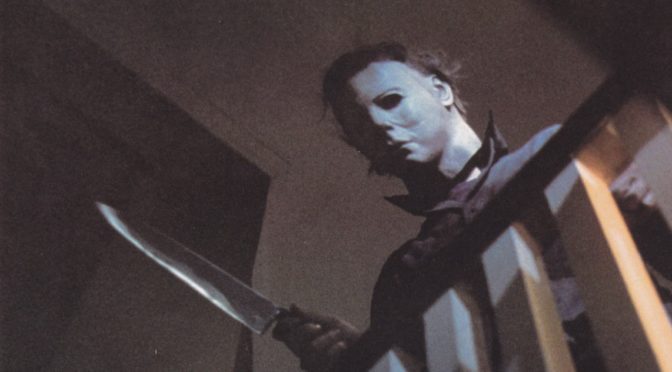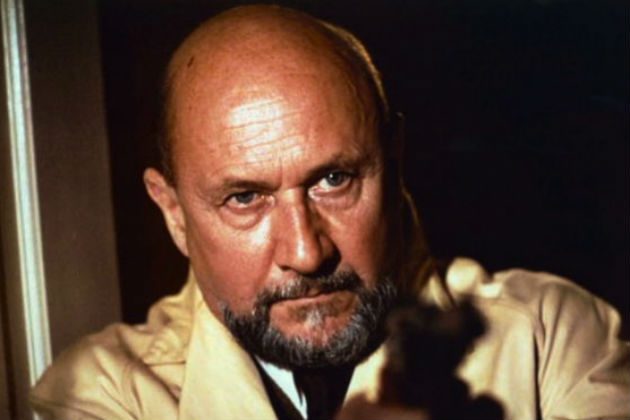“It’s Halloween. Everyone’s entitled to one good scare.”
Have you ever wanted to yell at a movie screen? I mean loudly, desperately, cup your hands around your mouth and belt out “He’s right behind you!” John Carpenter’s Halloween is a movie made expressly for this kind of interaction. It might not have been the first slasher flick, but it certainly established a template that many films have tried unsuccessfully to follow since its release. In many ways, modern horror wouldn’t exist were it not for Halloween.
Which is kind of amazing when you consider what a slapdash production it was. The fact that Halloween is so damn good is a testament to Carpenter’s skill as a filmmaker, but also to the “Let’s put on a show” ethos of the production. Carpenter directed, co-wrote, and scored the film, producing possibly the greatest horror theme song ever written; his editor Tommy Wallace (who directed It) was also a production designer. As we all know, the Michael Myers mask was a William Shatner mask painted white. Halloween should have looked haphazard and thrown-together; instead it’s a classic. A lot of films follow a rulebook; to watch Halloween is to watch the rulebook being written.
Look how effectively Carpenter uses a now-tired trope, that of the immortal boogeyman. It’s easy to forget, after a wave of crappy sequels, that in the first Halloween Michael Myers was actually scary. He’s afforded no real motivation; the closest we get is Dr. Loomis (Donald Pleasance) describing him as “pure evil.” (Loomis also refers to Myers as “it” or “the evil,” in foreboding tones straight out of Poe or Walpole.) Carpenter utilizes lots of long, unbroken shots that put us in Myers’ POV; even when not shooting from anyone’s point of view, he uses voyeuristic shots to make it seem as though the characters are all being watched. It creates the kind of tension that makes you want to yell at the screen, to do something, and it’s also a nice stylistic homage to Michael Powell’s Peeping Tom, long considered the first slasher movie. Watching things unfold from Michael’s point of view – like the bravura opening shot – is a good way to make him an “other”; we get no sense of him as a human being, only a faceless, murderous entity.
I always think of Halloween as a film that takes place primarily at night, but some of its eeriest moments happen during the day: Michael following Laurie (Jamie Lee Curtis) around town, watching her in class, watching her from the clothesline. Daytime is supposed to be safe, so what’s this hulking masked lunatic doing, and how does he slip away so easily? It’s here that you have to remember that in 1978, Michael Myers’ silence was a pretty novel trait.
One thing established in Halloween that later movies wouldn’t take into account is believable, if not always likeable, characters (looking at you, Friday the 13th). The group of kids at the film’s center might not be people you necessarily want to hang around with, but I buy them as teenagers, and when they mention characters we never meet, it makes for a nice bit of world-building, as if they have lives outside of the film’s events. Jamie Lee Curtis makes her film debut here as Laurie Strode, and it’s something of a casting masterstroke.
When the bodies start to pile up, what makes it scary is the senselessness of it all. Michael really has no reason for killing Laurie’s friends, and for a while Laurie doesn’t even know that they’re dead – there’s a masked killer across the street and she has no idea. When she runs from Michael, she screams for someone, anyone, to help her, but true to the logic of nightmares, no one can hear her. Carpenter is equally gifted at staging suspense and otherworldly horror, and the two blend together excellently in Halloween (he would later perfect the balance with The Thing).
Like a lot of horror movies, Halloween spawned way too many inferior sequels (if the best actor in your movie is Busta Rhymes, which is the case in Halloween: Resurrection, you are in serious trouble), but the difference is, Halloween actually kind of sets that up. Movies like The Exorcist or Rosemary’s Baby didn’t need sequels, but they got them anyway. Halloween has such a terrifically ambiguous ending that it would be a surprise if it didn’t spawn a franchise. Michael Myers gets stabbed, shot, and falls out of a window, but when Laurie looks out, he’s gone. Fade to black.
Subsequent Halloween films failed because they took this plot point to its illogical extreme – I’m pretty sure he survived a beheading in H2O, but I might be misremembering that – and Rob Zombie’s 2007 remake failed in showing us way too much of Michael’s home life. (Would it surprise you that the Myers family was a bunch of trashy rednecks? It wouldn’t?) Carpenter’s film, however, remains as immortal as its villain.
***
Well guys, that’s a wrap on 31 Days of Fright. It’s been a lot of fun, and sometimes it’s been an enormous pain in the ass. I got to watch a lot of horror films for the first time; some of them are woefully undervalued (Cujo), some criminally overrated (Friday the 13th), and some are new favorites (Little Shop of Horrors). All in all, this was a blast, and I want to thank you for reading. See you next year.
(Check out the full 31 Days of Fright archives here!)



